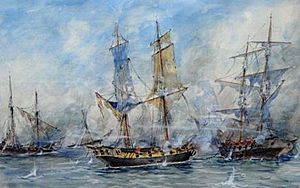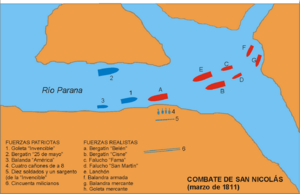Battle of San Nicolás facts for kids
Quick facts for kids Battle of San Nicolás |
|||||||
|---|---|---|---|---|---|---|---|
| Part of Argentine War of Independence | |||||||
 |
|||||||
|
|||||||
| Belligerents | |||||||
| Commanders and leaders | |||||||
| Jacinto Romarate | Juan Bautista Azopardo | ||||||
| Strength | |||||||
| 7 ships | 3 ships | ||||||
| Casualties and losses | |||||||
| Unknown | 3 ships captured | ||||||
The Battle of San Nicolás was an important sea battle that happened on 2 March 1811. It took place on the Paraná River in South America. This fight was between the Spanish royalists (people loyal to the King of Spain) from Montevideo and the very first small fleet of ships created by the new government in Buenos Aires. This battle was the first time these two groups fought on the water in the Río de la Plata area since the May Revolution started. The Spanish royalists won this battle.
Contents
Why Did the Battle of San Nicolás Happen?
On 25 May 1810, the people in the River Plate colonies (which are now parts of Argentina and Uruguay) decided to take control from the Spanish ruler, called the Viceroy. This event is known as the May Revolution in Buenos Aires. They felt they needed their own government because Spain was in trouble, being taken over by Napoleon's French army.
However, the Spanish leaders in Montevideo did not agree with this new government. They decided to stop ships from entering or leaving Buenos Aires by setting up a naval blockade. Montevideo was also a big navy base for the Spanish fleet in South America. Because of this, the new government in Buenos Aires, called the Junta Grande, decided they needed their own navy to fight for control of the local waters.
How Was the Rebel Fleet Created?
The new government in Buenos Aires, the Junta Grande, chose Francisco de Gurruchaga to be in charge of their navy. He worked very hard to build a small fleet of ships.
Gurruchaga managed to buy five different types of ships from local owners. He then put cannons on three of them. Most of these cannons were old and not used anymore, but they were all the new government had. The ships he got were a schooner (a type of sailing ship), a brigantine (another type of sailing ship), and a sloop (a small, fast ship). They were named "Invencible" (Invincible), "25 de Mayo" (25th of May), and "América" (America).
Finding people to work on the ships was also very difficult. Most people living in the pampas (the flat grasslands) were not used to life at sea. So, the solution was to hire sailors from other countries, many of whom did not even speak Spanish. Local people filled the lower ranks on the ships.
The leader of this new fleet was a sailor from Malta named Lieutenant Colonel Juan Bautista Azopardo. He had come to the River Plate area earlier in the 1800s and had fought against the British when they tried to invade in 1806 and 1807. Azopardo commanded the "Invencible". His main helpers were Hipólito Bouchard on the "25 de Mayo" and Ángel Hubac on the "América".
What Was the First Mission of the New Fleet?
In early 1811, the Junta Grande was fighting battles on many sides against the Spanish royalist forces. A small army led by Manuel Belgrano had been sent to Paraguay to help the people there join the revolution. After winning one battle, Belgrano's army was defeated and had to retreat.
The Junta decided to send more soldiers and cannons to help Belgrano. They gave this important job to Azopardo. His mission was to transport these extra troops and artillery up the river to Paraguay. Azopardo raised his flag on the "Invencible". The "25 de Mayo" was led by Hipólito Bouchard, who was French but had become an Argentine citizen. The sloop "América" was commanded by another Frenchman, Abel Hubac.
The Spanish leaders in Montevideo found out about these plans. They sent their own group of ships to stop the rebels. This mission was given to Jacinto Romarate, a very skilled officer. He had seven small warships, which were better and had more powerful cannons than the rebel ships.
The Battle of San Nicolás
Azopardo's ships left Buenos Aires and sailed up the Paraná River. When they got close to San Nicolás, they saw the Spanish royalist ships. Azopardo decided it was time to fight. He ordered some cannons to be taken off the ships and set up on the riverbank. He also prepared a group of sailors and local fighters to fight from the shore.
The battle began on 2 March when the royalist ships moved closer to the rebels. At first, two royalist ships, the "Belén" and the "Cisne", got stuck near the shore. This made them easy targets for the cannons on the riverbank and the rebel soldiers. However, Azopardo could not get his men to board these ships, and they eventually got free and moved away.
After several hours, the royalists attacked again. They fired at the "Invencible". The "América" was hit many times, and a large hole opened in its front, causing it to fill with water. The crew had to leave the ship. The royalists then focused their attack on the "25 de Mayo". They tried to board it (jump onto the ship to fight hand-to-hand). The rebel crew, who were not well-trained, panicked and jumped into the water, even though Bouchard tried to stop them.
The royalist ships then surrounded the "Invencible", which was now fighting alone. They boarded the ship. The crew of the "Invencible" fought bravely for almost two hours. But the situation became impossible to win. Azopardo tried to blow up the ship's gunpowder storage, but the wounded sailors begged him not to. So, he had no choice but to surrender.
What Happened After the Battle?
This defeat meant that the rebel fleet was destroyed. The Spanish royalist fleet from Montevideo gained control over the Río de la Plata, Paraná, and Uruguay rivers. This control lasted until 1813, when a new rebel navy was created and won important victories under William Brown.
In the short term, the extra soldiers and cannons that General Belgrano had asked for never arrived. Just a few days after the battle at San Nicolás, Belgrano's army was attacked and defeated at the Battle of Tacuarí on 9 March 1811.
Juan Bautista Azopardo was captured by the royalists and taken as a prisoner to Ceuta, Spain. Even though he was a prisoner, the revolutionary government in Buenos Aires started a legal process to find out what happened in the defeat. The report they got said that Azopardo was brave. However, it also said he lacked experience as a commander and allowed his crew to be undisciplined. The punishment was that he could not be a commander in the armed forces anymore, and could only serve as a lower-ranking officer.
While imprisoned in Spain, Azopardo faced charges for supporting the revolution. He was sentenced to death, but his punishment was later changed. Finally, in 1820, a liberal movement in Spain led by General Rafael de Riego freed all political prisoners, including Azopardo. This allowed him to return to South America. The next year, Buenos Aires changed its earlier decision and allowed him to return to military service in the Argentine Navy.
The governing Junta told the people about the defeat in a public announcement on 4 March 1811.
See Also
- Argentine Navy
- Juan Bautista Azopardo
- Action of 14 May 1814
- Battle of Martín García (1814)
 In Spanish: Combate de San Nicolás para niños
In Spanish: Combate de San Nicolás para niños


